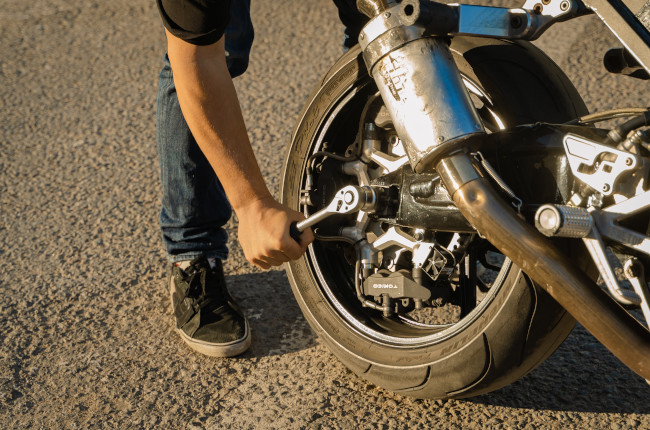Is it illegal to change my rim size?
Thinking of going up or down a size? Read this first.

If you’re a dual-sport or trail rider, classic bike aficionado, a cafe racer enthusiast, or a rider who simply enjoys modifying a motorcycle, swapping your rims out for a different size may have crossed your mind—whether that means a different diameter or a different width. After all, there are a few benefits to be had from swapping out your rim size and customizing one's bike to suit your desired riding style should be something to consider. No matter the case, swapping out your rim size may not exactly be legal for usage on public roads as these types of modifications can also be a cause for accidents and other safety concerns. If you’re considering swapping out your rim sizes, you may want to tread with caution.
Why do riders change rim sizes?

More often than not, a change of rim size is often pursued because of usability, practicality, or performance. Riders who often venture off-road may decide to increase the front rim size to a 19 or 21-inch diameter in order to make the motorcycle more usable over rocks and ruts. Other riders might find it more practical to downsize from an 18-inch rim to a 17-inch rim in order to gain more access to tire options or to decrease seat height for added comfort. Other riders who are professional racers might also choose to fine-tune the way their motorcycle rides by going up or down rim sizes in diameter or in width. Regardless of the reason, the option of replacing a motorcycle rim provides the rider with a lot of flexibility in how a motorcycle can be better equipped for the rider’s needs.
What does the law say?

While changing your rim size might sound quite exciting for more reasons than one, it would be important to know that rim size changes are not always safe. Differences in diameter and width can negatively affect the handling, suspension geometry, and even safety as mishandled rims on installation can deform or even break and cause accidents. Moreover, the Department Order 2010-32 of the LTO states on Section 5.2 that a change of rim size is an illegal modification and is grounds for denying registration—riders can also be penalized up to P5,000 and have their motorcycle seized for impounding until the illegal modification is corrected.
So yes—it is illegal to change the rim size of your motorcycle. While there is no provision that states if a change of rim size refers to diameter or width, it would be best to err on the side of caution and retain the stock rim on your motorcycle. You can still replace your rim if you would like to upgrade to a higher quality rim or a different colored rim. Your new rim, however, must retain the exact same specifications as your original one in order to avoid complications with the law. You can also change the rim on your motorcycle if it will not be used in public roads, such as on track-only or trail dedicated motorcycles that do not traverse public streets and are instead transported on trailers or in trucks.
Benefits of staying stock

That being said, staying stock is not necessarily a bad thing—in fact, the law is there to help prevent riders from getting into hazards and safety concerns. Staying with your rim setup guarantees that the materials used and the assembly of your rim passes manufacturer quality control. Moreover, staying stock also means that your suspension geometry remains true to the design of your manufacturer. Suspension geometry is a very tricky business which your motorcycle manufacturer pretty much perfected for the given components of your motorcycle. As such, staying stock ensures that your motorcycle’s chassis, suspension, and wheels will provide you with optimal handling and feedback for the riding it was designed for.
Related Articles
-
Have these documents ready when buying a used motorcycle / Featured Article
Here are some essential documents you need to ensure are complete before buying a used motorcycle.
-
Why you shouldn’t change your brake light color / Tips & Advice
If you've ever considered changing your brake lights to a different color, you may want to read this first.
-
Are two-stroke motorcycles legal in the Philippines? / Tips & Advice
Motorcycles have come a long way in emissions standards. Find out if you can still ride a two-stroke motorcycle today.
-
Here's why riding with busted lights is a recipe for disaster / Tips & Advice
Avoid complications with the police and repair that busted lamp as soon as possible.
-
5 common motorcycle modifications you don't need / Tips & Advice
It may be wise to think twice about a few modifications you might have planned for your motorcycle.
Latest Features
-
Big bike versus small bike: which one is better for your lifestyle? / Featured Article
Here are a few tips to decide if you should get a big bike or small bike depending on your lifestyle.
-
Axial versus radial calipers - brake technology explained / Featured Article
Today, let’s talk about the differences between radially and axially mounted calipers, and determine the situations which are ideal for either.
-
3 things that make the Honda ADV 160 the perfect small-displacement all-rounder / Featured Article
Here are three reasons why the new Honda ADV 160 is one of the best small-displacement scooters in the market today.








